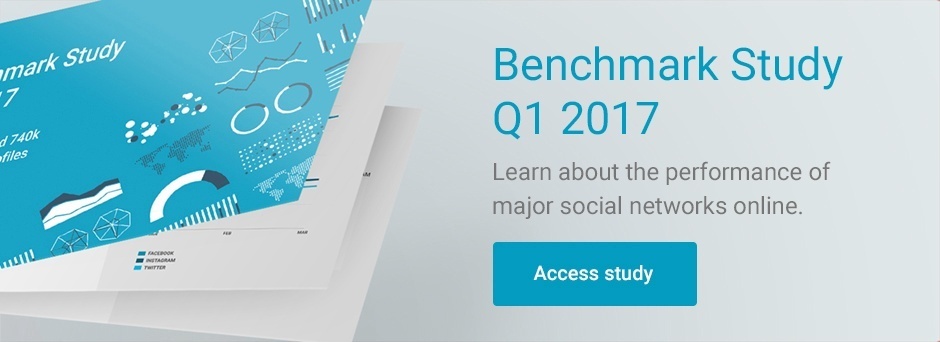
Do you also have problems finding the average Interaction Rate on Facebook in your industry in order to benchmark your own performances? If yes, here is the solution.
Your Facebook content marketing strategy is good as long as your average Facebook Interaction Rate is. Therefore, one of the most important Facebook KPIs - if not the most important - is the interaction rate. You can measure the success of your page performances with your interaction rate. The idea is to gauge how engaging your content is. Through the interaction rate we can get a better idea on how successful social initiatives are in terms of driving their audience to take the intended actions.
“Never measure your social media success in isolation. Always compare yourself!”
Always compare and benchmark against competitors on an industry level and see how your average interaction rate stacks up against the others. Through this approach, you are able identify flaws in your strategy and learn from your competition or best-practice examples.
However, marketers often face the challenge not knowing whether their own interaction rate is good or bad. The major challenge that digital marketers face today regularly is the lack of an accurate figure to benchmark their performances. Here is our effort to help you make sense of your average interaction rate of your Facebook page and how your social performance compares within your industry. On the left hand side of the graphic below, the averages per industries are displayed.
At times, comparing within the industry also doesn’t tell you the entire story. For instance, a less-known local clothing brand (with 10,000 fans) in Cologne or Valencia cannot compare or benchmark against a global clothing tycoon like H&M (with more than 31 million fans). Therefore, don’t blindly accept the average interaction rate for the industry level. Digging deeper within your industry and finding the average interaction rate by profile size is a better approach to benchmarking. This is why we have broken down each industry into two clusters, as it is in the nature of a formula such as the interaction rate that the number of followers and own posts, heavily influence the result, not only the amount of received interactions.

Some Important Tips Regarding Interaction Rate
You can calculate your average interaction rate on a page level. Once you know your interaction rate, you can compare it with the relevant profile size in the graphic above (on the right hand side). If you are at the average, or even above, it tells you that you and your team most likely do a good job in delivering relevant content at the right time to your fans. However, if your interaction rate is lower, you should dig deeper and try to find potential ways for improvement. Another good way is to put your audience first and think of their expectations and realign your message accordingly.
Secondly, you can post more compelling and engaging content and try different and perhaps new formats. Ideas here: Upload Facebook Native Videos, utilize Emoji’s and set up goals with strategies per network.
Among all that, a low interaction rate does not necessarily mean that your content is bad. It can also mean that your Facebook Reach is too low. Meaning to say that always means to dig deeper and try to find out the reason of low absolute interactions or interaction rate. Low Facebook Reach can have many reasons such as posting in the wrong post types or you might consider a budget for sponsoring content.
Important Takeaways
- The average interaction rate on Facebook across all the analyzed industries is 0.21%.
- Smaller sized Facebook pages tend to achieve higher interaction rates. Therefore, you can use our interaction rate data above as a proxy according to size of your Facebook pages.
- Broadly speaking, the average Interaction Rate on Facebook across various industry is low. All industries have interaction rate below than 0.5%.
Background Information to our Analysis
Analyzed time period: 1st half of the year 2017; 25,000 Facebook profiles have been analyzed
We clustered industries by the officially given Facebook categories. To give you a feeling of the companies who are in these buckets, here are some brands part of the individual categories.
For instance: Qatar Airways has decided to categorize themselves as Travel company even though most of its competitors listed them under “Airline” Category!!
Food and Beverages: Starbucks, Subway, Ritter Sport Chocolate, Ruslan Vodka
Retail Company: Snapdeal, Kaufland, Lesara, Foot Locker
Internet/Software Company: PayPal, Skyscanner, Buffer, Alexa.com, Facebook
Media/News Company: BBC News, The Guardian, Time, Financial Times
Travel Company: Qatar Airways (NOT Airlines), Disneyland
Health/Beauty: Nivea, Colgate, Dove, Freeletics
Electronics: Beats by Dre, Nokia, Saturn, Samsung, Xbox
Clothing (Brand): Mango, Zara, Tom Ford, John Players
Cars: Mercedes-Benz, Audi, Kia Motors, BMW, Rolls-Royce Motor, Porsche, Ferrari
Summing Things Up
Social media data starts becoming meaningful once you compare with competitors. Data on its own does not reveal whether you have been successful or not. This applies for social media analytics as well as revenue or conversion rates on a landing page. In our analysis, we showed the average interaction rates per industry as a first step. As clusters always contain profiles with very different sizes, we split them in two. This is more insightful as it does not make sense to compare a young and emerging clothing brand with H&M. All numbers are ‘just’ averages and are never 100% accurate. If you want to compare yourself with your competition or your specific industry, it always makes sense to do that for the specific social profiles you want to analyze. With having a better understanding of the interaction rate, the next step needs to be looking at different metrics such as Average Interactions Per Post or interactions received per post type.
Recommended Readings
Learn how to write the perfect social media post
Start benchmarking on social today!
Our in-depth Facebook Analytics Guide


Join the conversation. Leave us a comment below!